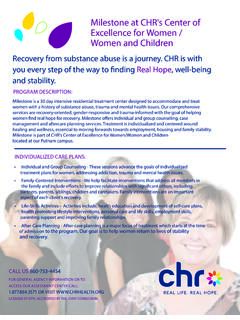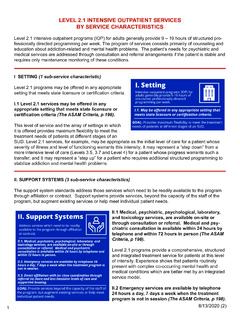Transcription of Step by Step
1 An initiative of the Conrad N. Hilton Foundation, in partnership with The National Center on Family Homelessness, National Alliance to End Homelessness and ZERO TO THREE: National Center for Infants, Toddlers and by Step:A Comprehensive Approach to Case management Written March, 2011 IntroductionWhat is case management ? How do you choose the right approach for your organization? What supports do case managers need to provide quality services? Case management is one of the primary services offered to individuals and families who face multiple challenges, including severe mental illness, addiction, and homelessness.
2 As the practice of case management has evolved, the term has become increasingly complex. Many organizations offer case management without clearly defining what this means, why they chose a particular approach, how it relates to existing case management models and outcomes, and how they prepare case managers to provide these services. This brief outlines steps organizations can take to design a comprehensive approach to case management , including: Researching and designing a model. Supporting staff in providing case management services.
3 Evaluating One: Researching Models and OutcomesResearching case management models and related outcomes is the first step towards articulating a comprehensive case management approach. Organizations with a working knowledge of case management models can make informed decisions about which model or models to incorporate in their management Models The term case management encompasses a range of strategies and services that have evolved over decades. Case management was originally designed as a service for people with severe and persistent mental illness.
4 Prior to the 1950s, mental health care was provided mainly in public mental hospitals and included mental health services and day-to-day supports. Significant changes in mental health service delivery, including new medications to manage mental illness and a movement towards community-based mental health centers, contributed to the deinstitutionalization movement of the 1950s and 60s (Smith, Schwebel, Dunn, & McIver, 1993). This led to a dramatic increase in discharges from psychiatric hospitals and an increased need for services in the community.
5 It was difficult for people with significant challenges and needs to navigate community-based systems of care and to access psychiatric services. In 1977, the National Institute of Mental Health established the 2 Community Support Program (CSP) to improve coordination of community mental health services. This led to a new approach referred to as case management and new professionals referred to as case managers (Mueser, Bond, Drake, & Resnick, 1998).A case manager was initially defined as an entity (usually a person) that coordinates, integrates and allocates care within limited resources, with primary functions that include assessment, planning, referral, and monitoring (Rapp & Goscha, 2004).
6 Working within this traditional approach to case management , known as the Broker Model, case managers are responsible for assessing and referring people to community-based service providers as needed and monitoring these service connections (Mueser et al., 1998). This remains as a common model of case management ; however, the paucity of community-based resources, long waitlists, and the intensive needs of many people who receive case management services has lead to the creation of new service models and shifting roles and responsibilities for case managers.
7 As various models of case management have emerged, case managers have moved from primarily coordinating services to providing services as well. The approach to service design and delivery varies by case management model. To address more significant mental health needs, the Clinical Case management Model uses clinicians as case managers who provide direct, therapeutic support. Strengths and Rehabilitation Models focus on building strong relationships; emphasizing strengths; providing choice, autonomy and control; and assisting people in accessing and developing environmental and personal resources.
8 intensive models such as Assertive Community Treatment (ACT) and intensive Case management (ICM) are defined by small caseloads, team structure, and increased provision of direct service rather than making referrals (Mueser et al., 1998). Critical Time Intervention offers time-limited, intensive case management designed to support people in establishing community connections and supports (see Figure 1. for common case management models).Strengthening At Risk and Homeless Young Mothers and Children3 Step by Step: A Comprehensive Approach to Case ManagementStandard Community Care ModelsBroker Case management ModelThis traditional approach to case management focuses on assessing needs, referring to services, and coordinating and monitoring on-going treatment.
9 The case manager serves as coordinator of services, which are provided by a variety of agencies and professionals. Services are mainly Case management ModelThis model uses clinicians as case managers to provide some direct services. Case management functions include engagement, assessment and planning, community linking, individual skills-building through interventions such as psychotherapy, psychoeducation, and crisis intervention. Much of the work is Comprehensive Care ModelsAssertive Community Treatment (ACT)Originally created by Stein and Test, the Program for Assertive Community Treatment (PACT), was designed as a community-based alternative to the hospital for those with severe mental illness.
10 The ACT model is an intensive , comprehensive approach to case management , and is defined by small case loads (10:1); a multi-disciplinary team approach (usually at least two case managers, a nurse, and a psychiatrist); shared case loads; services delivered by the team in person s natural environment vs. making referrals outside of the team; unlimited timeframe; and 24 hour coverage. A range of services are provided ( , mental health, housing , daily living skills, socialization, employment, crisis intervention, substance abuse treatment).


















